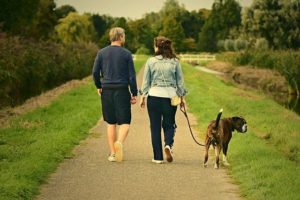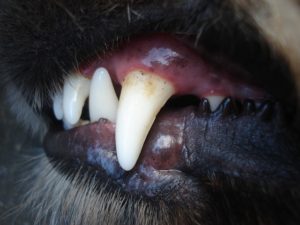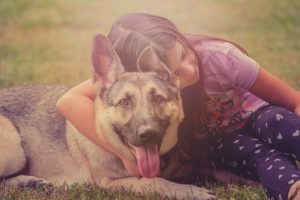Growing old is a fact of life, for all of us. It happens. One thing to remember though, aging is not a disease…it’s a process we all go through. It shows we’re growing old and living life. Nothing was meant to last forever (except your love for your dog and his for you). The point is to walk every path, sniff every scent and enjoy the journey together by following this guide of 9 of the best ways you can help your senior dog live longer.
We all want our dogs to live their best life. Their longest, happiest life. The Great news is that you can make a difference in how long your senior dog gets to remain by your side by managing how you spend your time together, what he eats, and the trouble he gets into. Or doesn’t.
1. Encourage a Healthy Senior Dog Diet
A dog with a healthy weight is a dog with a longer life. Overweight or obese dogs are at higher risk for a whole host of diseases, including high blood pressure, kidney disease, heart disease, diabetes, and even cancer. Feeding your dog the right food for his age, activity level, breed, and any health conditions can go a long way towards keeping him at his best weight and health.
The quality of the food you feed your dog matters too. Read labels and research the ingredients. Know what you’re feeding your dog. Look for high quality proteins, items you can pronounce and limited to no fillers, but also talk to your veterinarian or canine nutritionist to come up with a plan of what to feed your one-of-a-kind dog. The best food for your pet is the food he does best on.
You might even consider switching to real meats, fruits and veggies with your Veterinarians guidance. Remember though, some foods we enjoy are actually poisonous to dogs: grapes, raisins, chocolate, certain nuts, xylitol and many more items in your pantry and medicine cabinet. The Pet Poison Helpline is a good resource to make sure you keep dangers out of paws reach.
2. A Healthy Body Comes from Exercise
Exercise is proven to lower stress, increase endorphins, and balance mood and emotions in people and dogs alike. The type and amount of exercise your dog needs should be tempered by his age, overall health, and activity level that is natural for his breed, but dogs should get at least 30 minutes of exercise every day. It will help keep him lean, his muscles toned, and will stimulate his mind.
In addition to helping your dog maintain a healthy weight and muscle mass, and keeping her cardiovascular system in shape, regular physical activity will help keep her happy. If you want to prolong her life, consider prolonging those evening walks. Better yet, let your dog romp off-leash with a canine friend or two: socialization with other dogs is another way to reduce her stress and improve her overall quality of life. So, stretch those four legs daily to help circulate blood and oxygen and keep joints flexible.
Cold, wet weather may make aging joints ache, but daily exercise is crucial. Improvise during inclement weather by supervising your pooch on a doggie treadmill, romp indoors chasing a ball or other favorite toy, heck, you can even do laps around your local pet store where he’s sure to get added attention by the staff and other patrons.
“Engaging in physical activity together is an important component of the human-animal bond. Humans and dogs are the only two species that interrelate this way. Dogs and people were designed to walk, run, and play side by side.” Ernie Ward, DVM
3. Keep Your Senior Dog Busy
It’s important to keep your senior dog mentally and physically strong throughout its life but sometimes, as they age, they may need a reminder of the manners and tricks they learned earlier in life. This can definitely:
- Keep your dog from danger. Recall is especially important.
- “Leave it” can prevent him from eating that gooey, smelly oh-so-tempting puddle on the floor that could be toxic!
- allow you to put on your dog’s leash or wait for a treat, which is oh so nice as opposed to chomping your finger off grabbing for a treat.
- keep him from running into the path of a car.
- be like a game of follow-the-leader as you keep your best pal by your side.
Like people, all dogs, especially senior dogs, thrive on mental stimulation to keep them happy. A bored dog can become depressed, anxious, and even ill. You can extend your dog’s life by keeping her busy. As she ages, keep her mind active with training, socialization, games, one-on-one attention, and other enrichment activities. There are puzzle games, a virtual hide and seek for healthy treats. Also, take your dog to new places, go for a drive, go camping, hiking, or just journey backwards on your typical walk, mix it up and help your pet sniff new smells, see new things and engage all his senses.
“Don’t think of your senior dog as tired and old but instead as a pal in retirement. He still has good years ahead of him and can enjoy walks, fun but low-impact activities such as swimming and nose work, and toys that challenge his brain, keeping it sharp.” America’s Veterinarian, Dr. Marty Becker
4. Stay on Top of Dental Hygiene
Don’t forget to brush those chompers! Dental hygiene is an often-overlooked aspect of pet care. Many of us, simply forget to brush our dogs’ teeth on a regular basis. Unfortunately, poor oral hygiene can lead to plaque, gingivitis, and eventually periodontal disease, a bacterial infection of the mouth that has been linked to heart disease and organ damage in dogs.
The good news is, it’s not hard to keep your dog’s teeth in tip-top shape. Simply brush their teeth regularly. Once a week is fine or a few minutes a day in short bursts if you also provide safe chew toys, dental treats, and have the vet check the teeth at annual visits.
5. Follow Your Veterinarian’s Advice
Even if your dog is the picture of health, she should visit the vet at least once a year for a general check-up, and twice a year as she enters old age. One of the best ways to ensure your dog has a healthy senior season is to make sure he stays fit and strong in his early years. Annual visits keep your dog at his peak and ward off possible disease through vaccinations and early detection of problems. Also, talk to your Vet about common illnesses and ailments for your dog’s primary breed.
Wellness exams are meant to maintain optimal health, and they provide a concrete record of your dog’s health history as she ages. They also give your vet the chance to spot potential problems early on, and a problem detected in its early stages is more likely to be treated and resolved successfully. Spaying or neutering can lower risks of certain cancers, prostate infections and pyometra – a serious infection of the uterus. (Link to spay/neuter post)
Sticking to a regular preventative care routine will give your senior dog the best shot at a long, healthy life.
“A dog can have up to 75 percent loss of kidney function and still appear just fine on the surface. Schedule lab tests twice a year for golden oldies to keep tabs on their internal functioning and catch problems early, when they are more manageable.” –America’s Veterinarian, Dr. Marty Becker
6. Adopt a Senior Dog (Mixed Breed)
According to Barkpost.com, “Mutts and mixed breeds tend to live longer than pure-breeds. Well you know how genetics work. In-breeding = health problems. Lots of varied DNA = a stronger, healthier dog.” Makes sense to me!
7. Tune In to Your Senior Dog
One of the most valuable things you can do consistently for your senior pooch is to give him a weekly Head-to-Tail assessment. Gently feel from the tip of his ears down to the end of that waggly tail checking for lumps, bumps, parasites, burrs – anything that shouldn’t be there. There is nothing like the professional eyes, ears, hands, stethoscope, blood test and urinalysis he get from his second best friend (aka his veterinarian) that can find something happening inside before you ever suspect something’s not quite right.
Catching a problem early and reporting it to your veterinarian could be a money-saver or even a life-saver! Any change in appetite, bowel movements, activity levels, sleep patterns, behavior, bad breath, drooling, breathing troubles or congestion, digestive issues or anything out of the ordinary can be a sign of a potential problem in your senior dog.
8. Share Your Senior Dog with Others
Strong bonds make strong pups. Plus, the more socialized a dog is, the less stressed out and anxious they are–and less prone to getting into a ruckus that results in an injury. This is where all that exercise comes in.
- Take your dog for frequent walks. Greeting other neighborhood dogs and their owners is a fantastic way to teach them how to properly greet a stranger and a strange dog for that matter.
- Have friends over. Start with a single person or a couple to be sure and not overwhelm your dog, especially if he’s not used to the activity and added noise.
- Once your dog seems comfortable around home and the neighborhood, work your way up to a dog park. If your dog is anxious or older, you might try just walking around the perimeter of the fence and let your dog watch the other dogs play from a distance. Work your way up to entering the fence and allowing your dog to sniff and interact with the other dogs. Take it slow and keep it positive.
- Sign your dog up for doggie daycare a couple of days a week. This can help ease anxiety and adjust quickly to new situations around new people and new dogs.
9. Lots of Tender Loving Care
Never, never, ever lose patience with your trusty best friend. As your dog ages, he may feel the urge to answer nature’s call more frequently and may not be able to let you know quick enough. Help him by increasing the frequency of potty breaks, install a doggie door to a securely fenced yard, line bedding with plastic to make for easy clean-up. Make your life simpler, as well as your dog’s. so that you can return that unconditional love and put any frustrations to rest.
Using runners on slick floors can really help an older dog get around better. Some even benefit from ‘toe grips’ placed on the nails that help provide better traction. –Heidi Lobprise, DVM, DAVDC
Consider doggie steps to allow your senior to still curl up on the bed or sofa next to you. If there’s a special window he enjoys watching the mailman from, maybe an ottoman or other cushion could be placed to allow his fun habit to continue.
Depending on the ailment, warm or cool may serve your dog best. You might use a heating pad under a blanket on his bed if he has arthritic joints. Laying on the heating pad (lowest setting of course, a way to move away from the heat, and no direct contact-place a towel or soft blanket over the heating pad) can really help to comfort him and ease that pain.
For others…
“Keep the house cool at night. Seniors often get a heat spike between one and three am. Keeping the house cool can reduce night-waking.” Kathleen Cooney, DVM, MS, CHPV
Enjoy Every Moment with Your Senior Dog
Your time together is precious, so maintain healthy habits, keep your dog active in body, mind and spirit. Savor every minute.
The sad fact of dog parenthood is that people typically outlive their pets and there are no miracle products that will extend your dog’s life far beyond the natural lifespan of her breed. But with conscientious care, enrichment, and regular veterinary attention, you may be able to give her a few extra years.
You’ve been together a long time. You are your senior dog’s favorite person and spending time together is why you share this life in the first place. Really make time for quality time each and every day. That precious soul waits anxiously for you to come home. Don’t drop your bags, pat him on the head and go onto other things. Don’t talk or text when you are out on walks, and when he can’t be on the go as much, sit quietly together listening to the wind blow or the birds sing. Something you’ll be able to do to remember him when he’s no longer by your side.

